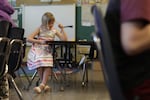For as many as one in five of us, learning to read can seem almost impossible. Researchers say that’s about how many Americans have dyslexia. For decades, schools have often failed to recognize and support dyslexic students who look at letters and words in very different ways.
But in the last few years, dozens of states have mandated new approaches to dyslexia. Oregon joined that effort last year.
Many students go through Oregon schools not realizing they're dyslexic, or not getting help to understand letters and words, which may not piece together the way they do for typical kids.
One of the children OPB is following over the next several years as part of the Class of 2025 project, was evaluated as dyslexic.
When Shelby was in first grade at Earl Boyles Elementary in Southeast Portland, she loved feeding her family's chickens and playing with her older brothers and sisters. But she was also happy to flip through her favorite book, “The Little Mermaid.”

Shelby follows along in class at Earl Boyles Elementary School in Portland. Shelby is one of many students who struggles with dyslexia, something Oregon lawmakers are targeting.
Bradley W. Parks / OPB
“Her daddy’s doing a party and she needs to get decorations," Shelby said, turning a page in the picture book. "They all have a job.”
Shelby wasn’t reading there. She was describing the pictures.
Shelby is one of 27 kids in OPB’s “Class of 2025” project. They're now in fourth grade.
Last spring, Shelby laughed when asked what her favorite part of school was.
“Well, I don’t really like school," Shelby answered. "Just kidding.”
Shelby likes to kid around, draw and tell stories. But Shelby’s mom, Julie Anderson said reading is still a struggle.
“There’s the picture, and then just a few words — but for some reason, there’s not a connection," Anderson said. "So, it was a constant push-push-push with her.”
Shelby was evaluated last year and found to qualify for help, due to a learning disability. Dyslexia was slowing her down.
Related: Class Of 2025: Follow Students From 1st Grade To Graduation
“When they said to me at the school there was going to be testing, we’re going to see what’s going on and then it came down to what the truth is, there was relief in it — that ‘thank you, now we know what’s going on,’" Anderson said, with Shelby on the couch next to her. "But there was a sadness in it.”
“Why?” her daughter asked.
“Just because, I, you know just said that there was something ..." Anderson's voice trails off. "It’s hard to choose your words with that. I’m still trying to find those words.”
In Spring 2015, as Shelby’s mom was confronting dyslexia at home, Oregon lawmakers were tackling it at the state-level. It was a personal mission for House Majority leader, Val Hoyle, D-Eugene. She told the Senate Education Committee that she was dyslexic herself, but didn’t know as a child.
“What I felt was I just wasn’t as smart as everybody else," Hoyle said, her voice cracking. "In second grade, my teacher — I remember — Sister Marie Louise put a turtle up on the wall with my name on it, because I couldn’t write and finish the assignments as fast as the other kids.
"I am 51, and I remember that,” Hoyle said.
Legislators easily passed two laws (SB 216 and HB 2412) to improve Oregon's support for students who are struggling in school due to dyslexia.
Oregon schools are supposed to start screening kids for dyslexia risk in kindergarten or first grade, beginning next school year. Each elementary school should have a teacher trained in dyslexia by the beginning of 2018.
When it comes to teaching, an advisory committee recommends that the same good reading principles for most kids applies to dyslexia.
Shelby’s been getting intensive reading help for years. She would get drilled on letter sounds in the special education room.
"Th. Ah. Ss," Shelby said, as her teacher Jennifer Mazalook observed, occasionally correcting her.
Shelby also worked in a small reading group with her teacher. Last year in third grade, that was with Nicole Rauch. On one spring day, she worked through a passage about dolphins.
"They need to come to the … fff ... fff ... fah …" Shelby read aloud, until she got stuck on a word.
“Surface,” Rauch corrected.
"Surface to … breathe?" Shelby read tentatively.
“Mm, hmm,” Rauch murmured, encouraging Shelby to keep going.
Shelby easily read some words in that passage, but got stuck on others, like “surface,” which she tried to start with the second syllable. That's one way that Shelby's dyslexic reading can trip her up.

Shelby draws on her animal balloon, made for her by a local clown, at Earl Boyles Elementary School.
Alan Sylvestre / OPB
Dyslexia isn’t the same for everyone and Rauch says she didn’t learn about any of it when she was getting her teaching degree. That’s supposed to change under Oregon’s new dyslexia laws. Rauch taught herself what she knows. Rauch said she has also noticed over the years that children with dyslexia often have significant strengths, too.
“[Shelby] is very creative in how she talks and plays and just interacts with people and that’s definitely something that maybe dyslexia has kind of helped cultivate in her,” Rauch said.
Some dyslexic kids use their other strengths to compensate for reading difficulty. But that can be its own problem, the way special education interventions tend to work. If students are not falling behind, they may not get special help. Teachers familiar with Oregon’s new laws say that situation won’t necessarily change.
The prescribed approach — intensive reading help — doesn’t work miracles for kids like Shelby, either.
“She’s made a lot of progress; there’s a lot more to be made," Rauch said. "She’s got a long road.”
Shelby’s new fourth grade teacher agrees the 9-year-old is working hard, doing all the right things, but is still significantly behind her classmates in reading.
